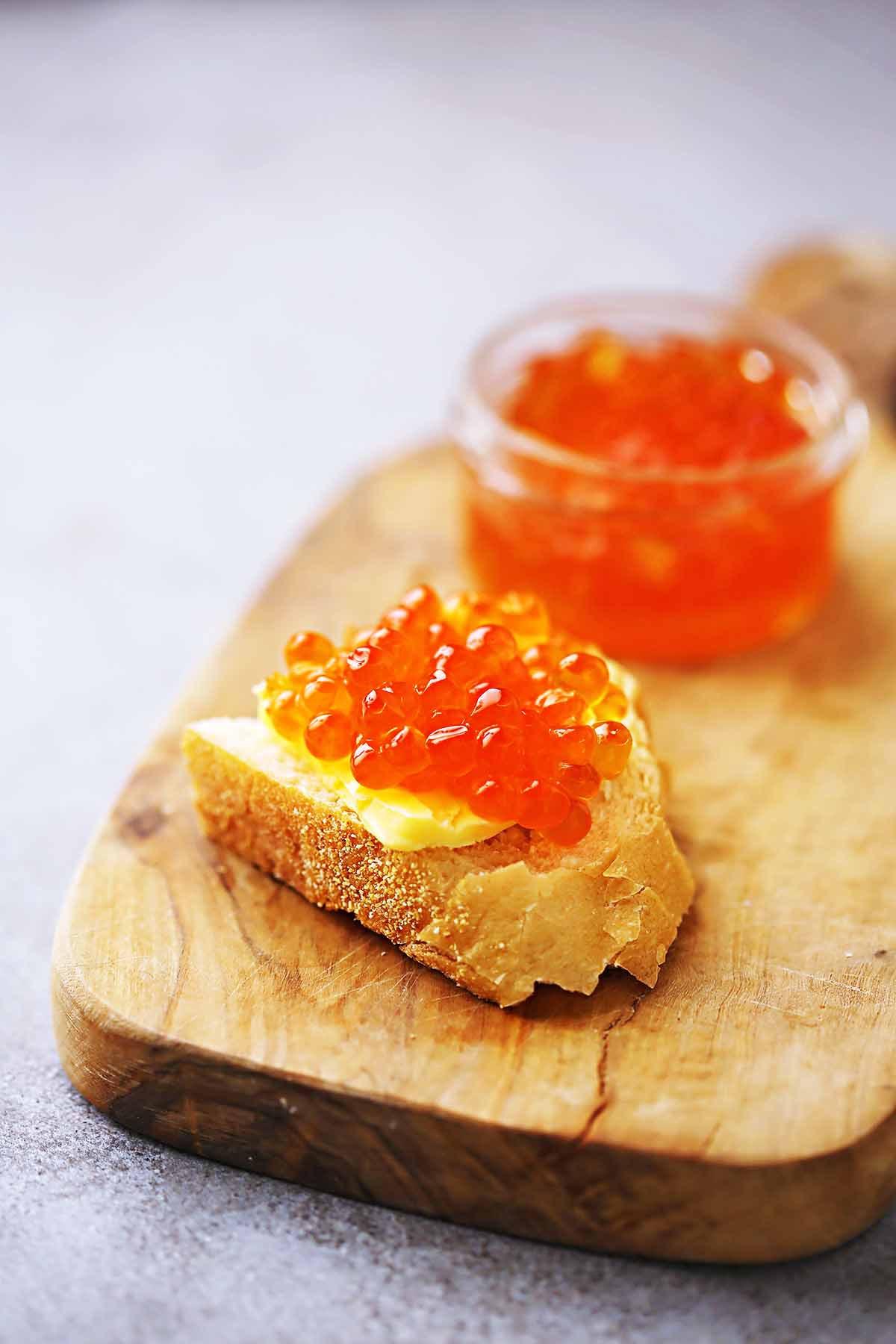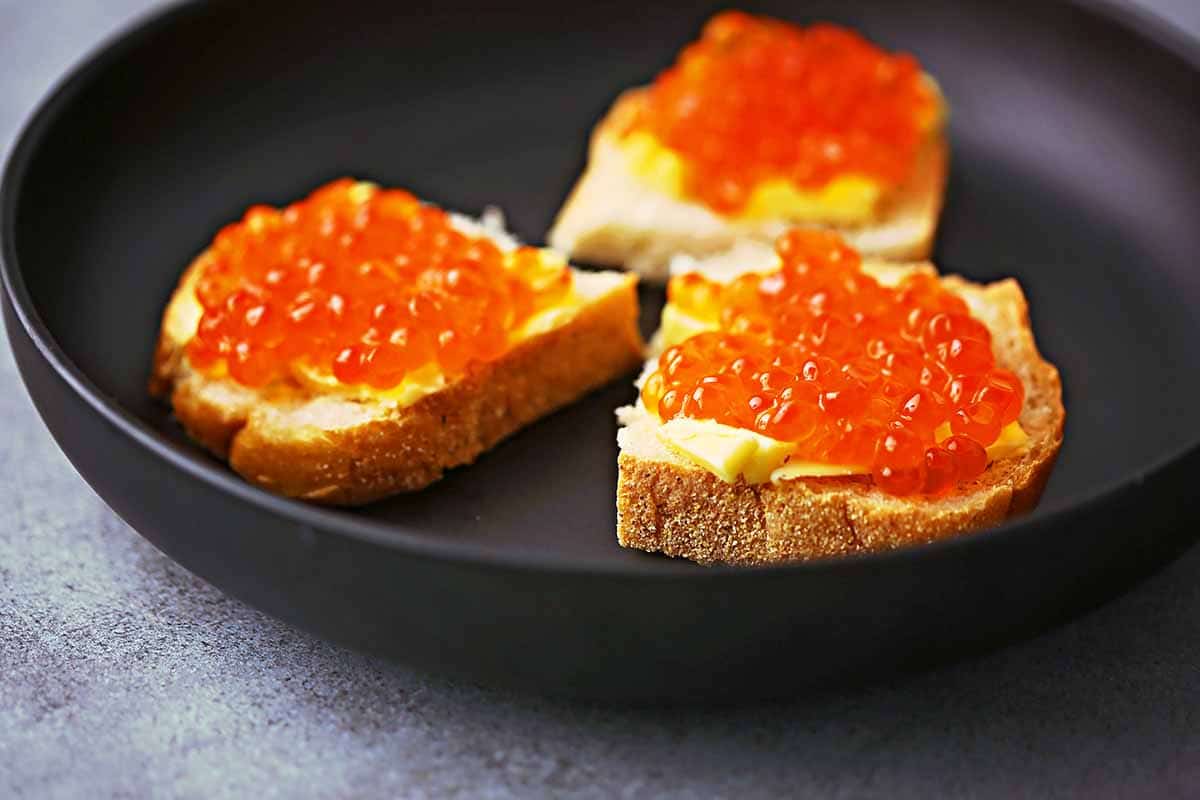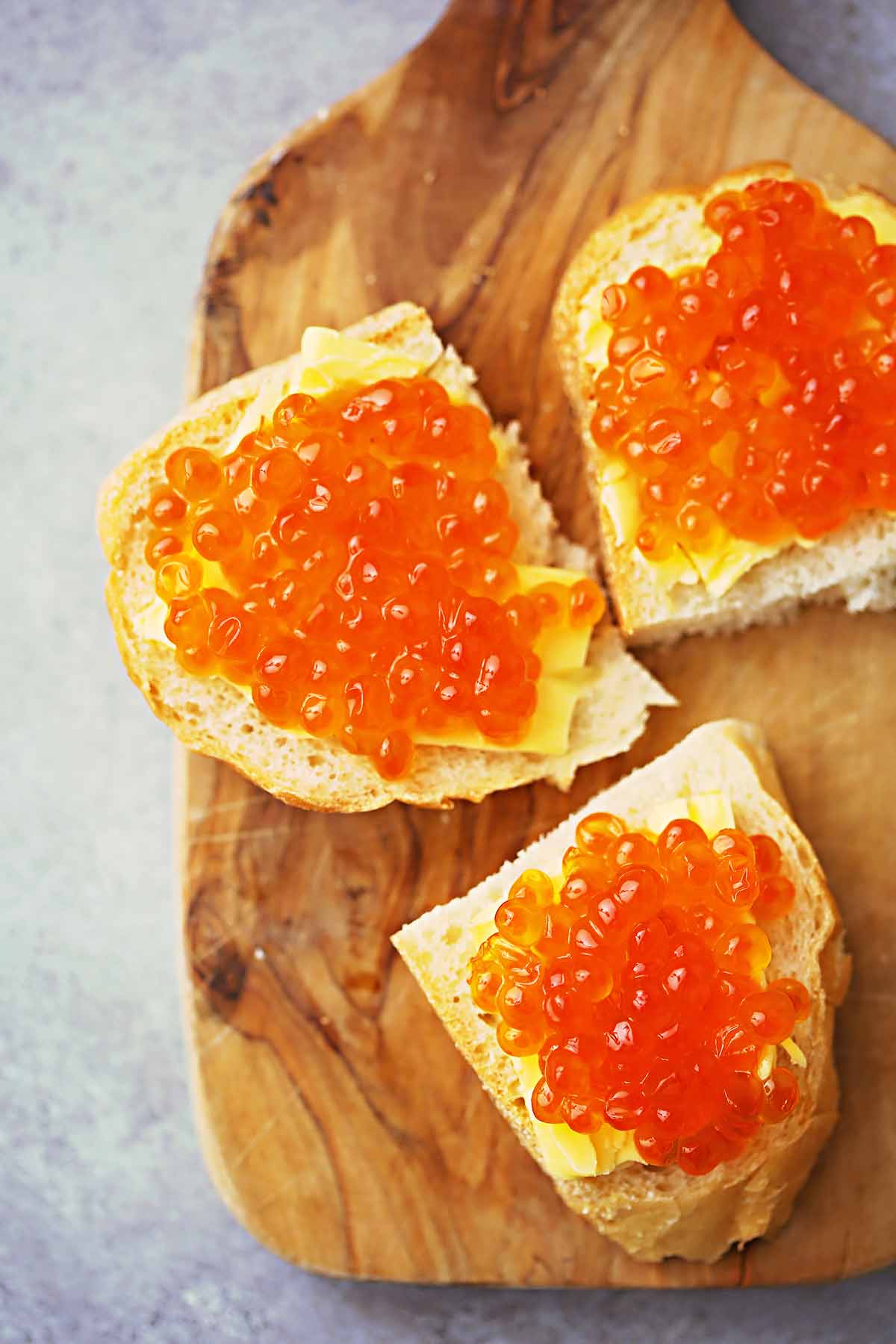Learning how to eat caviar is a unique experience that requires skills and knowledge. Served caviar makes one of the most sophisticated and luxurious foods on your table.
Not everyone has the opportunity to eat this sumptuous dish. This article aims to help you eat caviar and look like you know what you’re doing, guaranteed!

To eat caviar is a synonym for fine dining and special occasions. It’s why you will want to learn more about it: it’s different types and flavors.
Caviar is the roe of sturgeon fish of the Acipenseridae family, harvested and preserved with salt. It is a traditional name in the Caspian and the Black Seas in North-Eastern Europe. The roe, of course, must be extracted from the fish, which is not particularly easy.
Sturgeons are prehistoric animals, and it sometimes takes up to twenty years for the fish to produce eggs. Some sturgeons and similar fish grow in ponds to obtain the roe easier, but others must still be caught in the wild, making their caviar rare and expensive.
Caviar producers extract the roe, rinse it and cure it in sea salt. The correct proportion between roe and salt is often a trade secret, as producers look for the freshest flavor and the most extended shelf life. No wonder sturgeon caviar is one of the coveted food in the market.
At this stage, the producers are ready to can the caviar and send it to the market. It comes without saying some types of fine caviar are pasteurized and have a longer shelf life, but most experts agree the fresh stuff is much more flavorful, even if more perishable.
Read on and learn more about the most common types of caviar and their characteristics. With this knowledge, not only do you become familiar with how to eat caviar correctly, but you also know how to serve caviar on the table.
The rarest and most luxurious roe comes from Beluga sturgeons from the Caspian Sea, although Beluga caviar is now rare as the fish depletes. Still, the fish eggs are large and glossy, with a dark gray hue and a rich taste.
Considered as good as Beluga, but not quite the same, this fish roe comes from Osetra sturgeons, and the medium grains show a dark brown, almost golden color fish egg. In addition, osetra caviar is less nutty.
Sustainable sources of caviar from farmed sturgeons and hybrids fish eggs have slowly substituted Osetra and Beluga caviars. This offers an excellent option for those who love to eat caviar every day!
Sevruga caviar captures the third spot in popularity; it’s famous for its small, gray fish eggs with a salty flavor. It offers a creamy and buttery taste. This caviar is much more common than Osetra and Beluga caviars.
Usually, higher quality caviar like the Sevruga has preferably eaten alone or on toast or blinis. Although it’s the same as the Beluga and Osetra, it has a more intense taste, and so it’s best to serve caviar as a delicious appetizer.
This type of caviar comes from the River Sturgeon of the same name. The fish also comes from ponds, so it’s much more sustainable than wild-caught sturgeons. It is the largest river fish globally, and they often breed the species with other sturgeons to create new and exciting types of caviar.
Kaluga’s medium-grained, golden-brown fish eggs are buttery and salty. When serving caviar, you may prefer to eat it alone, one tiny spoonful at a time, or you make it garnish on your baked dishes. Whatever your desired ways to eat caviar, the point is, you must savor its taste.
This variety comes from the Sterlet sturgeon, native to the Caspian Sea. It is a small fish, but it grows faster than other varieties. The grains of this sturgeon caviar are light gray and quite flavorful, and you may mistake this variety for Sevruga.
The authentic American caviar has gained recognition for its quality, affordability, and availability straight from the Mississippi. This type of caviar comes from the American White Sturgeon that is farmed. These are medium-small, firm, and dark eggs, and they can be pretty nutty.
Many different types of fish roe exist in the market and are pretty enjoyable. Although not caviar, salmon roe, paddlefish roe, bowfin roe, and trout roe are also famous. Sure, the most coveted caviars on earth are expensive and sometimes illegal, but there is plenty of fish in the sea for caviar lovers!

There are many ways to enjoy caviar, but you need to serve it correctly to make the most of it. The proper storage temperatures, the amount of caviar to allot per person, and the right sides are critical to ensure caviar delivers its best.
Caviar is a delicate food, so you must always purchase it just a few days before you plan to enjoy it, never over a week. Further, store caviar in its tin in the back of the fridge to ensure a stable temperature of around 39.2°F (4°C).
Avoid opening the can long before you’re ready to serve the caviar to prevent contamination and deterioration. Although caviar benefits from cold temperatures, never store it in the freezer, as the delicate grains can burst when frozen, getting damaged irreparably.
Leave the tin of caviar to ‘temper’ at room temperature 10 minutes before serving. In this case, you can open the can, but keep it on over a larger bowl filled with crushed ice to prevent it from warming up too much. You might need to change the ice a few times while you wait so you won’t serve warm caviar.
Always keep in mind to serve caviar chilled. If you have to arrange it on the table, putting caviar over crushed ice maintains its serving temperature. By doing this, you preserve its quality and freshness.
Serving caviar in the can is perfectly fine for casual get-togethers but transfer the roe into a small crystal bowl with a crystal or mother of pearl spoon for more exclusive dinner parties. Remember to consume the entire tin, as storing caviar for later is never recommended. For the best caviar experience, try to finish it in one sitting.
Traditionally, caviar lovers never expose the roe to metal bowls or spoons, as it gets ‘tainted’ with a metallic taste. Or the salt content of caviar may react to the metal and produce an aftertaste. So. caviar tins are coated with a non-reactive material to protect the roe’s delicate taste.
Instead, use crystal spoons, specially designed for serving caviar, if you’re planning on eating on its own. Utensils made of bone, ivory, wood, or mother pearl are also customary, and they add to the experience, but they are not necessary to enjoy caviar. Even plastic spoons work fine, although they may look out of place on a fine dining table.
If you’re buying caviar for a dinner party, consider 1-2 ounces (3-5 teaspoons) per person so you won’t have leftover caviar or a shortage of it. Standard caviar tins and jars contain anywhere between 3.5 and 16 ounces. No matter what, make sure you have enough caviar for everyone. Avoid buying too much or too little — ask your guests to confirm their attendance and base your purchase on the number of expected guests.
Eating this black caviar with others calls for dining etiquette because you can’t have it to your heart’s desire. However, if it’s a family affair or you’re eating alone, then enjoy caviar to your liking. There’s no right or wrong how you eat caviar when you’re alone.

A widespread way of serving caviar is placing it on the center of the table, allowing your guests to dig in. So, how much caviar is enough and too much? In this case, scooping up more than two teaspoons of caviar is considered a bit too much, so take it easy. The usual serving is per teaspoon. For example, you can put one teaspoon of caviar on your toast point or unsalted crackers. Otherwise, the host can serve the caviar individually in more complex preparations.
When you eat caviar, don’t chew but feel it with your tongue to savor and enjoy it. Serve Beluga chilled on toast points or unsalted crackers; it’s the preferred way to eat caviar of this finest quality. It’s so expensive that you may want to taste it by itself to appreciate its taste.
Caviar on its own is a beautiful appetizer suitable for cocktail parties where you’re serving canapés and other finger food, and not necessarily dinner. However, caviar stands alone as a crowd-pleasing bite before a full dinner, and it can very well be the first course in a multi-course meal.
However, there’s no limit to what kind of food pairing caviar can be. It’s your taste; it’s your choice as long as the food tastes delicious. Creativity is a good thing because that’s how popular cuisines originate.
Classic caviar service includes white bread toast spread with unsalted butter, blini (small pancakes), rye bread, crumbled hard-boiled eggs, or boiled potatoes. In all of these cases, a teaspoon (½ ounce to 1 oz) of caviar is enough to bless the one-biters with its sea-scented flavor.
Having a wide variety of sides on the table will allow your guests to mix and match the delicate roe to their liking.
Never spread caviar over anything but gently place on top of the accompanying side to prevent the eggs from bursting.
Chefs have gotten increasingly creative with caviar, and the delicate roe is now part of sophisticated dishes, from pasta to scrambled eggs. When eating caviar, creativity is encouraged.
From salads to seafood chowders, caviar is more versatile than you can imagine. Unfortunately, caviar doesn’t take heat very well, so it’s best in cold or room temperature preparations.
The most traditional beverage for caviar is plain high-quality vodka, served straight out from the freezer. Vodka is pure ethanol and water, so it doesn’t interfere with caviar’s flavor. Vodka is a great palate-cleanser that will help you enjoy every mouthful as much as the first one.
Dry Champagne is also an excellent partner for caviar, as its tartness is astoundingly compatible with fish roe.
Now you know all there is about caviar to serve it with confidence. It is a fantastic addition to your diet, so taste it and see if you like it. Maybe serve it to your guests next time, it’s an excellent way of making your meals more exciting!





